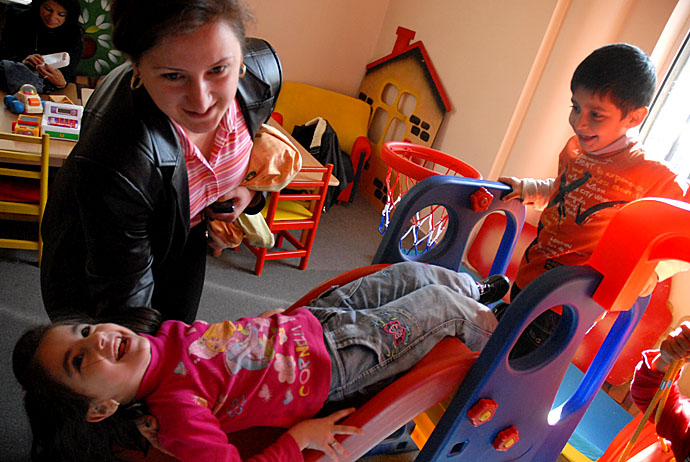
According to official statistics, there are over 8,000 children with disabilities living in the Republic of Armenia. In part the legacy of the soviet-era but also the result of the present socio-economic situation, many of these children have been isolated from society and are excluded from mainstream education.
[...]
"We are creating equal opportunities and access to education for children with disabilities," says Susanna Tadevosyan, President of the non governmental organization (NGO) Bridge of Hope. Established in 1996, the NGO continues to expand based on its experience to date and is implementing programs in nine different areas.
[...]
"My daughter was born with Cerebral Palsy," says one mother whose child has benefited from the work of the NGO. "Relatives tried to convince me that my daughter, Ashkhen, wasn't normal and would destroy my life and that of my family. My husband abandoned me and I was left alone with my child."
Ashkhen grew up in isolation and was deprived of the opportunity to interact with other children until she was later enrolled into a specialized boarding school that offered only a watered-down curriculum for children with learning disabilities. Separated from her mother for most of the week, Ashkhen returned home on weekends. In 1996, however, when her mother heard about the Bridge of Hope NGO, Tatevik was eager to find out more.
"When I entered the center the first thing I noticed was that there were non-disabled children there," she says. "I never thought that disabled and non-disabled children could relate to each other." Sixty percent of the children that attend are not disabled and of those that are, nearly half are diagnosed with cerebral palsy and a third with Down's Syndrome.
Over the years, while still attending the specialized school, Tatevik says that Ashkhen developed quickly, becoming more communicable and confident. In 1999, at the age of 15, Bridge of Hope helped Ashkhen make the move to a regular school close to where she lives. She is now one of the most active and high-achieving children in her class and thanks to including both disabled and non-disabled children in the centers, stereotypes are being broken down.
[...] They were treated by a speech therapist, an art therapist and a psychologist; participated in performances organized by World Vision. They learnt to communicate with other children, and were taught to read and write.
Tigran Tshorokhyan, World Vision's Technical Support Team's Child Protection Specialist, describes the Malatia center as just one part of the organization's work in the area of child protection. The main objective is the provision of relevant services to children with special needs in order to integrate them into mainstream education whenever possible. It also serves as a resource center for the other community centers, 10 of which have been handed over to local government.
We also undertake our own awareness raising campaigns which offer the real possibility to change the mentality of society and to make it more inclusive when it comes to children, and especially those with learning disabilities or special needs.
Of course, with integration in mind, the center is not just for children with special needs. There are also clubs which not only offer services to children with disabilities, but also to those from the local community. The children are aged from 3 to 18 years of age and the majority is enrolled in mainstream schools. Amalia Martirossian, the center's coordinator also says that it produces training and methodological materials for parents, teachers and children.
This is very important because these materials are in Armenian.
World Vision International Humanitarian organization with the funds raised by the Burns Committee in conjunction with the British Embassy presents a series of unique toys designed by World Vision Armenia specialists for the physical and mental development and rehabilitation of children with special needs.
During the coming two months World Vision Armenia will distribute these toys to inclusive kindergartens, schools and other inclusive, special, rehabilitation facilities in Armenia.
Home visits by the center's social worker, Anna Aslanian, are also part of its function. Living in the Malatia-Sebastia district of the capital, 12-year old Levon has Down's Syndrome and does not attend school although his younger sister, Lusine, does. His parents have been absent and working in Europe for four years now so the two children are brought up by their grandmother. Aslanian will visit a special school and attempt to have him enrolled there.
World Vision Armenia has a website at http://www.wvarmenia.am and there's a World Vision Armenia You Tube Channel here. Nrani has one at http://www.nrani.org. There are also older articles and photographs I've written and taken on the same or related themes for UNICEF and other organizations or publications available for download in PDF format here and here.

What do you think?